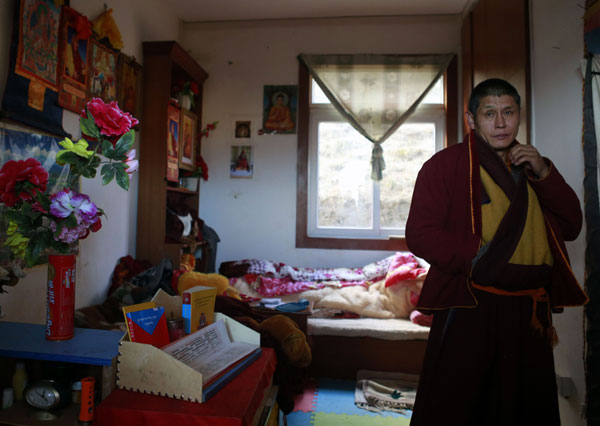Monks vent anger at self-immolation
Updated: 2012-12-21 08:18
By Cui Jia (China Daily)
|
||||||||
Nyima Roba, 17, said his friend's death is a huge loss. "His life was gone just like that. It's just too bad," he said tearfully. "What I did caused my parents so much pain."
Sonam Gyamtso said that when he is discharged from hospital, he will return to the monastery and be a good student.
However, Song is worried about their future. "They are suffering from deep, second-degree burns, which means their joints are severely affected. Also, their skin will become thinner and infection will set in more easily. Their quality of life will decline, and that will cause them great pain in the future," he said.
About 240 km from Aba county, lies Changlie Monastery, perched on a mountaintop at an altitude of 3,400 meters and with more than 800 years of history, in Barkam county, the capital of Aba Tibetan and Qiang autonomous prefecture. The snowcapped mountain is nicknamed "Dogtooth" because local legend says it looks like a canine incisor when viewed from the Potala Palace in Lhasa, the capital of Tibet autonomous region.
Meanwhile, in addition to a new hall, decked out with red floor tiles from Nepal, thankas - murals depicting Buddhist deities or scenes - from Tibetan-inhabited areas around China, and pillars of white marble, the modern monastery of Nyingma, or the Red Hat sect of Tibetan Buddhism, is now building a square for large-scale religious activities.
"Most of the monasteries of the Nyingma sect are built on mountaintops, because we want to retreat from society and practise Buddhism," said Tsewang, the housekeeper of the monastery, which is home to more than 90 monks.
At Gomang Monastery, which houses 432 monks, in Aba county, a new prayer hall covering more than 30,000 square meters is under construction and is expected to be completed in three years.
"It's going to be very modern and everyone is looking forward to it," said Katrug Gyalmotso, a monk of the Gelug sect, who has been at the monastery for 30 years.
Tsewang, who has been at Changlie Monastery for more than 25 years, said the local officials now fully understand their religion. "We appreciate their respect. They helped us build a new road in 2008 and pumped water up all the way to the mountain top."
After explaining the story behind one of the thankas, Tsewang sat and reflected on the recent spate of suicides by burning. Eventually, he looked up and said, "People need to question the real reason behind these self-immolations. Suicide is against Buddhist practice, so what other reasons do they have?"
 |
|
Asi, a 49-year-old monk, in his room in Changlie Monastery in Barkam county, Aba prefecture. |

 Relief reaches isolated village
Relief reaches isolated village
 Rainfall poses new threats to quake-hit region
Rainfall poses new threats to quake-hit region
 Funerals begin for Boston bombing victims
Funerals begin for Boston bombing victims
 Quake takeaway from China's Air Force
Quake takeaway from China's Air Force
 Obama celebrates young inventors at science fair
Obama celebrates young inventors at science fair
 Earth Day marked around the world
Earth Day marked around the world
 Volunteer team helping students find sense of normalcy
Volunteer team helping students find sense of normalcy
 Ethnic groups quick to join rescue efforts
Ethnic groups quick to join rescue efforts
Most Viewed
Editor's Picks

|

|

|

|

|

|
Today's Top News
Health new priority for quake zone
Xi meets US top military officer
Japan's boats driven out of Diaoyu
China mulls online shopping legislation
Bird flu death toll rises to 22
Putin appoints new ambassador to China
Japanese ships blocked from Diaoyu Islands
Inspired by Guan, more Chinese pick up golf
US Weekly

|

|







